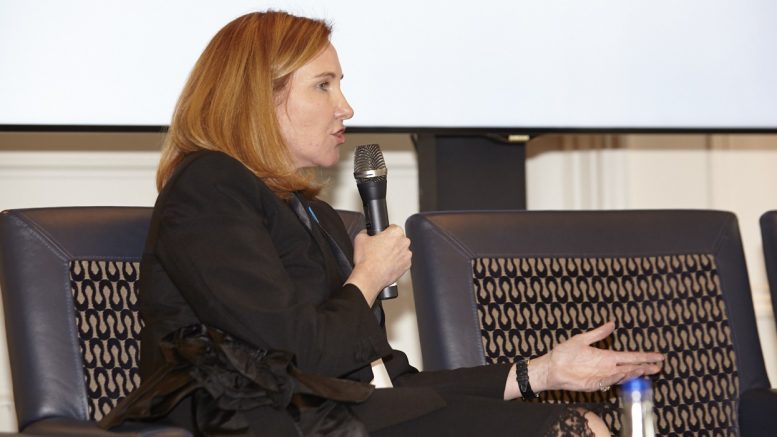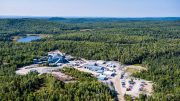LONDON, UNITED KINGDOM — The following is an edited excerpt of Lucara Diamond (TSX: LUC; US-OTC: LUCRF) president and CEO Eira Thomas interviewed by Dean MacPherson, head of business development for global mining at TMX Group, at The Northern Miner’s Canadian Mining Symposium held at Canada House in London, U.K., on May 22, 2019.
Thomas discusses the big picture for mining companies today, including: mergers and acquisitions, the impact of synthetic diamonds on natural diamond miners, and diversity in mining.
For more of her extended comments on Lucara’s production and its new Clara digital sales platform, look for a story in our upcoming issue of Diamonds in Canada, which will be released to coincide with our Canadian Diamond Symposium to be held in Toronto on June 20, 2019.
To learn more about the event, visit www.northernminer.com/2019-diamonds-symposium/
_______________________
Dean MacPherson: I want to jump right into it and get your opinion on the state of affairs in the diamond industry and the mining industry generally. What’s happening, what are you seeing, what are you feeling?
Eira Thomas: The common theme that we’ve heard a little bit this afternoon and generally within the marketplace is that the mining sector is a little bit unloved right now.
But we’ve got a lot to be optimistic about. The reality is there’s a huge demand for all sorts of mined commodities whether or not it’s metals and minerals going into new technologies, or it’s the energy that we use in our everyday lives, or when it comes to things like luxury products and diamonds.
If you believe in world GDP growth, then you have to believe in diamonds. I’m very optimistic. We’ve got a lot of opportunity in the space right now and we have to get out there and convince a new investor base that this opportunity is one that they should be seizing today.

Dean MacPherson, head of business development for global mining at TMX Group, at The Northern Miner’s Canadian Mining Symposium held at Canada House in London, U.K., on May 22, 2019. Photo by Martina Lang for The Northern Miner.
DM: Excellent. I love it. That’s exactly what I was thinking. We’ve heard a lot of doom and gloom and you often hear this tone these days in mining. So it’s good to hear optimism and remind ourselves often of how vital the industry we’re in is. And the fundamentals do support that, a return of investors eventually. So patience is required.
Earlier we had Mark Bristow here and a few CEOs talking about the M&A trend in mining. You’ve had experience in this. You were CEO of Kaminak that was acquired Goldcorp and you stated last year that M&A is a big part of your strategy going forward. I thought you could shed some light on your M&A activity.
ET: Sure. Or I could say nothing. [Laughs]
DM: Generally, what is your opinion about what’s happening in the industry.
ET: I had actually a lot of M&A transactions over my career, including one hostile takeover many years ago that I vowed never to ever repeat.
BM: You were the target or the acquirer?
ET: No, I was actually the acquirer. But it was such a long drawn out process, it took years of my life. So first I state that, I have no interest in doing hostile takeovers.
There’s a time and place for M&A, which is notoriously difficult to do and create value for all the shareholders.
I think we’re coming to a point certainly in the diamond sector where this is a space that’s very small and it’s been a difficult time for a lot of the junior producers in particular.
When Dominion Diamond got taken over by Washington Group, that was the premier investable mid-tier company. So that took a lot of energy out of the space and we’re left with a bunch of junior companies now that are really not investable in terms of their size.
We’re getting to that point where it does make sense to put these pieces together.

The Lesedi La Rona 1,109-carat diamond, discovered in 2015 at Lucara Diamond’s Karowe diamond mine in Botswana. Credit: Lucara Diamond.

Lucara Diamond’s Karowe Mine in Botswana. Credit: Lucara Diamond.
But for Lucara the challenge is we have a very high margin asset, we’ve got two growth projects in the pipeline that we’re very excited about. And our immediate focus is on executing on those organic growth projects that we have in our portfolio.
But of course, we’re continuously looking. We think that that is the prudent thing to be doing and we do think that the sector generally does need some consolidation and at some point, we believe that will happen.
DM: Are your investors pushing or clamoring for M&A activity? What’s the mood like on the investor side?
ET: It’s interesting for us because we are a dividend payer. We’ve been paying a dividend since 2014. We were the first diamond company to initiate a dividend policy and we’ve paid out $256 million in dividends, which is far in excess of the money we invested to build our project.
The dividend currently yields 7%. We have cash on our balance sheet and no debt.
So we’ve got investors that really own this story for that dividend and they’re very sensitive to that dividend. Including our chairman who is a larger shareholder who particularly likes his dividend.
The key message there for us is that, whatever we do, it has to be creative, it has to make sense, it has to add obvious value to our company and for our shareholders.
DM: In terms of jurisdictions, are you looking at Canada? Are you looking at Botswana? Wider Africa?
ET: Because it’s such a small space, we really can’t be too restrictive in our criteria. We look broadly, but of course, we risk-rank everything we look on the basis of geological potential, political jurisdiction, overall geological quality, of course.
All of that gets factored into our analysis, but I wouldn’t say that any jurisdiction is completely off limits for us. Obviously, we’re more comfortable in jurisdictions like Botswana. That would be our first choice, but obviously, Canada is not a bad choice either.
DM: The diamond industry last year got a bit of shock when De Beers announced its Lightbox synthetic diamond initiative. It’s tempting to see this as a negative event for miners. How do you see it?
ET: You know what? I’m actually really excited about it. I think it was a very positive development for the industry.
It clearly serves to differentiate the two markets. The synthetic diamond market is not the same as the natural diamond market and they can co-exist.
Right now, synthetics account for 3% to 5% of global jewelry consumption and that probably will grow somewhat. But we don’t see that encroaching into the natural diamond market particularly for purchases related to those important commemorative life moments.
And the reality is that a synthetic diamond that you would have purchased maybe five years ago for say, US$5,000 would be worth less than US$800 today. So less than a cellphone.
So there’s no store of value in a synthetic diamond. Rather, synthetic diamonds are filling a niche around fashion jewelry and we see it almost as an entry level opportunity for consumers.
I think for the women in the audience, they’ll appreciate that when you’re a young girl aspiring to own your first designer handbag, you’re not going to be out buying that until you probably have a few paychecks under your belt.
But that doesn’t mean that you don’t aspire. So you may go off and buy that fake Gucci handbag on 42nd Street in New York. That doesn’t mean it diminishes your appetite for the real thing when you have the opportunity to afford it.
Another analogy I use is thinking about how we consume luxury products. Everyone can appreciate that, as consumers, we have aspirations and we may have that designer item, whether it’s a suit or that Chanel handbag sitting in our closet.
But at the same time, we own Zara and we own Gap. It’s a continuum. They’re not mutually exclusive.
That’s how we see synthetics and natural diamonds playing together in this market. And because the cost of synthetics has come down so dramatically, those diamonds can never be resold for what they were purchased for. De Beers is clearly standing up and making a statement that this is the case.
DM: That’s a great analogy that you brought with retail luxury market. Very interesting.
Before we wrap up, I wanted to ask you a little bit about the ESG movement [environmental, social, and governance factors]. You started in mining over 20 years ago. So, very, very young. But when you started, the focus certainly was not very high on stuff like diversity and ESG in general. I wanted to get your perspective and what are you feeling in terms of the changes that you’ve seen from the time that you started as a geologist in exploration and mining. Are you optimistic about that next generation of leaders?
ET: I’m very optimistic. We have to be a little bit patient, but I also share the frustration that it hasn’t happened quick enough. What we’ve seen is that diverse companies are generally more profitable companies, are more successful companies. That is becoming very apparent.
For us at Lucara, we’re very proud of the fact. We’re actually 80% women in our senior leadership team.
DM: Founded by quite a number of women.
ET: Yes. And two partners and the original founders. Catherine McLeod is also a founder of Lucara. And something we’re also very proud of is the fact that we have the first female Botswana woman running our diamond company in Botswana. And she’s the first female leader to run a mining company in Botswana period. We’re also proud that 98% of our employees are Botswanan. We have no expats in our leadership team in Botswana at all. So this is something that we have embraced as an opportunity and it’s clearly paying off for us.
We just reported our Q1 results. The mine has never been stronger. We’re actually hitting record production through the plant. This is the best production quarter we’ve had in seven years of running this operation. We are exceeding guidance with ore and carats produced and we’re doing it safely.
We’ve just recorded our second full year without a lost time incident at our mine. All of these things contribute to better performance and Lucara is a really good example of that. And so we see the benefits, we continue to push forward on that basis. For us, it’s a no-brainer.
DM: I’ve noticed that your diversity program and your ESG program, in general, is quite impressive. Before we wrap up, do you have anything you want investors to take away?
ET: I think back to the way we open this, with this feeling that this is a sector that’s unloved. And I agree with that.
But we’ve got to turn that energy around. As leaders in the industry and as companies, we’ve got a great story to tell so we have to get out there and tell the story.
And we got to do it to a broader audience. Our tendency is to preach to ourselves and the converted. So a broader audience is a huge opportunity. Canada has got a great story to tell. The mining industry in Canada has a great story to tell and we need to get on with telling it.

Eira Thomas, president and CEO of Lucara Diamond, and Dean MacPherson, head of business development for global mining at TMX Group, at The Northern Miner’s Canadian Mining Symposium in London, U.K., in May 2019. Photo by Martina Lang for The Northern Miner.






Be the first to comment on "Diamond mining industry ripe for consolidation, says Lucara’s Eira Thomas "